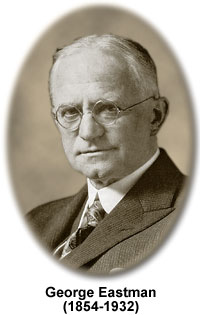George Eastman
(1854-1932)

From humble beginnings, George Eastman revolutionized the field of photography by simplifying the process and making it accessible to the masses. The youngest of three children, Eastman was born in Waterville, New York on July 12, 1854. His family moved to Rochester when he was still a young child in order that his father, George Washington Eastman, could establish a business school. However, his father died in 1862 and the institution failed.
At the age of 15, Eastman was forced to leave school to seek employment because of the family's financial difficulties. He began as an office boy in an insurance company, slowly moving his way up, and studied accounting in the evenings. In 1874, Eastman's extracurricular studies helped him acquire a position as junior clerk at the Rochester Savings Bank. The increase in income enabled him to consider activities he had not been able to afford previously and, in 1878, Eastman bought wet plate photographic equipment with the intention of recording a vacation he was planning. Although he never took that trip, the purchase changed his life forever.
The wet plate process commonly employed at the time was complex and required heavy, bulky gear that made it inconvenient to move. Eastman realized that there must be an easier method of photography and soon became immersed in experiments as he attempted to perfect a simpler dry plate process. He succeeded in his endeavor, and by 1880, had developed a machine that could mass prepare his dry plates. That same year Eastman officially went into business, selling the plates to other photographers. Initially lucrative, the dry plate market soon became inundated with competitors and Eastman was forced to find a way to distinguish his product.
Eastman continued his photographic experimentation, primarily focusing on finding a lighter and more flexible photograph backing than plates of glass. In 1884, he patented a paperbacked-film, and roll-holders to use with the material soon followed. The new photographic system was instantly successful, but Eastman was intent on reaching an even wider consumer base. He was struck with the idea of selling a preloaded camera that was sent back to the company for development and printing, making photography possible even for amateurs. In 1888, the first Kodak camera was ready to be sold and Eastman advertised in the leading periodicals, introducing photography to the general public to much acclaim. Consumers were impressed with the relative ease of photography, now only having to push a button to take a picture, and the company's triumph made Eastman an extremely wealthy man.
Remarkably generous, Eastman was fond of supporting a variety of causes and business endeavors. Some of his most notable philanthropic acts included establishing a music school, a theatre, and a symphony, as well contributing towards the development of a hospital and medical school in Rochester. He also frequently contributed to educational facilities, such as the Massachusetts Institute of Technology and the Tuskegee Institute. Eastman's generous nature also carried over into his business pursuits, establishing the first profit sharing plan for employees and offering retirement and health benefits when most other businesses did not.
In his later years, Eastman made yearly visits to Europe, kept a hunting lodge in North Carolina and went on frequent fishing trips. However, an increasingly debilitating disability spawned from spinal cord problems made the final years of Eastman's life more difficult. Having first attended to his estate, ensuring everything was properly arranged, Eastman committed suicide at the age of 77 on March 14, 1932.
